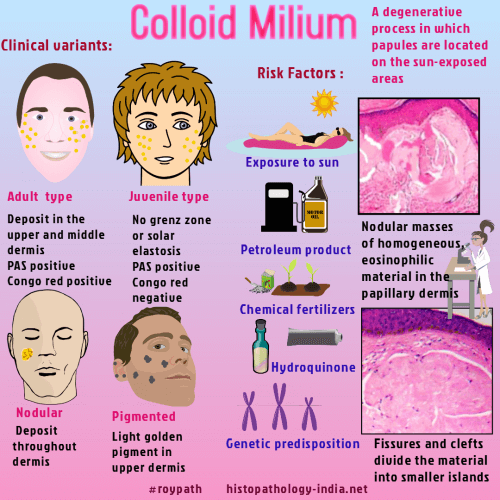|

Custom Search
|
|
Dermpath-India Pathology of Colloid Milium
|

Colloid milium is an unusual cutaneous disorder characterized by multiple cystic papules. It is a degenerative process in which the papules are located on the photoexposed areas. The material in the dermis represent a degeneration product of elastic fibers which is induced by solar radiation. Colloid milium and colloid degeneration include at least four distinct clinicopathological conditions: - Classic adult type colloid milium - Juvenile colloid milium - Pigmented colloid milium (hydroquinone related) - Colloid degeneration (paracolloid) Classic adult type colloid milium : - The adult form develops in sun-exposed parts of the body in patients who have actinic-damaged skin. - Develops in mid-adult life. - Plenty of yellow-brown, semitranslucent papules or plaques (1 to 4 mm in diameter) are seen in the cheeks, ears, neck, and dorsum of the hands. - Predisposing factors are exposure to petroleum products and/or excessive sun sunlight. Juvenile type colloid milium : - Exceedingly rare and develop prior to puberty. - Papules or plaques are seen on the face and neck. - Some cases are probably examples of erythropoietic protoporphyria. Pigmented type colloid milium : - Gray to black papules on the face, following the excessive use of hydroquinone bleaching cream. Colloid degeneration : - Nodules or plaque-like areas, on the face and is probably a heterogeneous group. Histopathology : Adult form: Histopathology images above: - Nodular masses of homogeneous, eosinophilic material expanding the papillary dermis and extending into the mid dermis. - Fissure and cleft divide this material into smaller islands and fibroblasts are commonly aligned along the line of fissuring. - A thin grenz zone of normal collagen, often with elastic fibers (which are also present between and below the colloid masses), separates the colloid material from the thinned overlying epidermis. - Colloid material may be stained positively with crystal violet and Congo red and fluorescence with thioflavin T (better result on frozen sections). - Absence of laminin or type IV collagen differentiates colloid milium from lipoid proteinosis and primary cutaneous amyloidosis. Juvenile form: - In most areas grenz zone is absent and basal layer may show hyalinization with a transition towards the dermal material. - The colloid is PAS positive and sometimes, methyl violet positive but it is usually Congo red negative. Pigmented form: - Lightly pigmented colloid islands are seen in the upper dermis. Colloid degeneration (paracolloid): - Amorphous, homogenized dermal collagen with less conspicuous clefts, extends deeply into the dermis. - The material is relatively acellular, weakly PAS positive but negative with Congo red and crystal violet.
|
|
|


